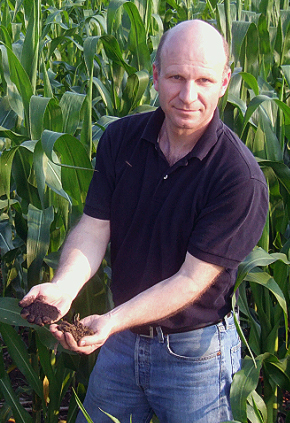Biochar reduces nasty nitrous oxide emissions on farms
By Blaine Friedlander

In the quest to decrease the world’s greenhouse gases, Cornell scientists have discovered that biochar – a charcoal-like substance – reduces the nemesis nitrous oxide from agricultural soil on average by about 55 percent and stanches emissions into the atmosphere. The research is reported in the new journal from Nature, Scientific Reports, April 25.
“We investigated the mechanics of denitrification, with particular attention to the climate-relevant nitrous oxide by adding biochar to agricultural soils,” says senior author Johannes Lehmann, Cornell professor of soil science. “Biochar consistently reduced nitrous oxide emission in agricultural soils.”
Carbon dioxide has a quiet, but strong partner in climate-warming crime – nitrous oxide. This nasty gas is usually produced on farms from animal manure waste and the use of synthetic fertilizer. In fact, nitrous oxide in agricultural soil has 298 times more global warming potential than carbon dioxide.

“Hence the importance to reduce emissions,” says Lehmann.
Agriculture in the United States accounted for almost 58 percent of all nitrous oxide emissions from 2003 to 2007, according to World Bank data, and almost 59 percent from 2008 to 2012. Generally, about 60 percent of all global nitrous oxide emissions come from agriculture, and about half of the greenhouse gas emissions in agriculture come from nitrous oxide.
“Despite this large importance of nitrous oxide for greenhouse gas emissions, there are very few strategies to mitigate the emissions in agriculture, compared to carbon sequestration in soils,” says Lehmann.
First author Maria Luz Cayuela, a former Cornell postdoctoral researcher in Lehmann’s lab and now at the Universidad de Murcia, Spain, led the study. The soils and the biochar spanned a wide array of types. Some soils studied were acidic, others neutral; some were sandy, others filled with clay. The researchers examined soils rich in organic carbon, while other soils possessed low carbon amounts.
No matter the soil type or the biochar type the scientists used, a universal truth emerged: the emission of nitrous oxide was always reduced on average by about 55 percent, compared to benign nitrogen gas.
The study, “Biochar and Denitrification in Soils: When, How Much and Why Does Biochar Reduce N2O Emissions,” was also co-authored by researchers Miguel Angel Sanchez-Monedero and Asuncion Roig, Universidad de Murcia; and Cornell technicians Kelly Hanley and Akio Enders
This work was funded by the Organisation for Economic Co-operation and Development, European Union Marie Curie Fellowship, U.S. Department of Agriculture, National Science Foundation and the Fondation des Fondateurs through the Atkinson Center for a Sustainable Future.
Media Contact
Get Cornell news delivered right to your inbox.
Subscribe